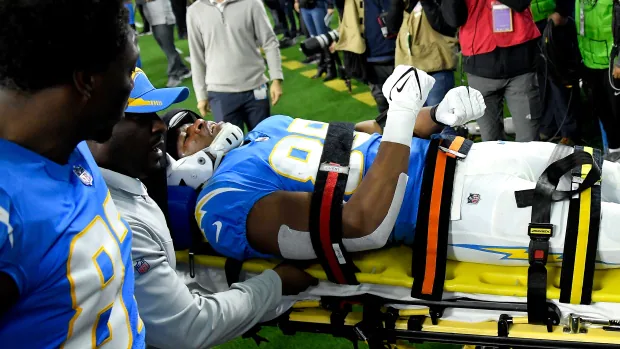
This is a column by Morgan Campbell, who writes opinion for CBC Sports. For more information about CBC’s Opinion section, please see the FAQ.
Adrian Peterson, the future Hall-of-Fame running back who finished this year on the Seattle Seahawks’ injured reserve list, said on Monday that he’s ready to play another season. Even though he has already logged 15 of them. Even though he turns 37 in March. And even though, as of right now, he’s a free agent.
If your NFL memory is long enough, you’ll recall Peterson as a six-foot-two, 220-pound punisher, who ran the ball with a bulldozer’s power and a cheetah’s speed. Late in the 2011 season he tore two ligaments in his knee, and he attacked his off-season rehab the way he did opposing tacklers. The following season he rushed for 2,097 yards, still the second-best single-season mark in league history.
He has always been — and, in a sports context, people mean this as the highest of compliments — a beast. But at nearly 37, Peterson isn’t just inching toward 40; he’s sprinting there, in a job where turning 31 makes you a senior citizen.
Last weekend marked the end of the NFL’s first 17-game season, and if the trip to the finish line felt endless and anticlimactic, it’s not you.
That extra week felt like three or four to sports fans trying to track the NFL while also following traditional winter leagues like the NHL and NBA. The league is demanding more than ever from its talent pool, which has to expand to include players, like Peterson, who would otherwise be watching along with the rest of us, as well as from our attention spans.
It all aligns with the relentless revenue growth the NFL expects — the league thinks it can gross $25 billion US a year by 2027. If future bargaining with the National Football League Players Association includes team owners pushing to expand the regular season even further, you’ll know why. Every extra regular season game is an opportunity to make more money.
But that cash isn’t free.
Staging more games, on more weekends, on more platforms, more nights of the week, erodes the scarcity that makes each game valuable. Each schedule expansion pushes games along the spectrum from appointment viewing, like a title fight, to mere inventory, like most of the 162 games in a baseball season. You can ask fans to pay close attention, or you can ask them to tune in every night. Few people, besides broadcasters and beat writers, can spare the mental energy to do both.
Physical toll to be paid
And there’s the cost to players’ bodies. In a league where players don’t load-manage, you’re inviting the injuries that create opportunities for people like Nick Mullens, promoted from practice squad afterthought to starting quarterback when a COVID outbreak hit the Cleveland Browns, and for Peterson, who rushed for 1,042 yards in 2018, but whose usage rate and yards-per-carry have slid steadily since then.
Anyone who follows the NFL knows the league’s “Next Man Up” ethos, and recognizes that most teams are only as good as their backups. But when the literal Next Man Up is a 36-year-old tailback whose reflexes and raw speed have dulled, we also have to acknowledge that the quality of the product is suffering.
Granted, the coronavirus pandemic scrambled both rosters and schedules this NFL season. The upheaval hasn’t been as extreme as in the NBA, where the Raptors fielded a starting squad that included some last-minute fill-ins who had only met their new teammates in the minutes before their lopsided loss to Cleveland. But, as Mullens’ emergency promotion showed, continuity can become a luxury in COVID-era pro sports.
Nine months ahead of the start of the 2023 campaign, we don’t know if we should brace for yet another season of pandemic football, with its schedule disruptions and patchwork rosters. But we can’t guarantee a new variant, or politicized opposition to reasonable public health measures, or the collapse of the health care system won’t upend the NFL’s next attempt at a seamless 17-game regular season.
Meanwhile, power brokers at the highest levels of U.S. college football are pushing to expand that sport’s playoff tournament — from four teams to at least six. More games for players on elite teams gives players on the fringes of the NFL draft more chances to show out for pro scouts, but it also creates more opportunities for future first-rounders to suffer serious injuries.
Add his name to an injury list of recent-vintage Alabama stars that includes Tua Tagovailoa (hip), Jaylen Waddle (ankle) and Brampton native John Metchie III (knee). These cherry-picked examples from a perennial title contender don’t constitute a trend, but they illustrate the risks players assume when organizers extend the season.
A generation ago, schedules at major football conferences in the NCAA maxed out at 12 games — 11 regular season, plus a bowl game for teams who earned invites. This season, Alabama and Georgia played 15, with each new game subjecting players to acute and incremental damage that can affect their draft stock and pro careers.
As the pro and college game both demand more output from the same group of players, something will have to give. They can play more, or they can play better, or they can play longer, but doing all three is nearly impossible.
If a 17th NFL game leads to an 18th, it’ll all lead to a workload that players can’t sustain, individually or collectively. Their bodies will suffer, or the quality of product will.
And if the NFL can’t depend on either of those commodities, what exactly are they selling, and why should we keep buying?